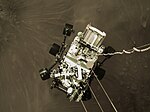람다 서펜티스
Lambda Serpentis| 관찰 데이터 Epoch J2000 Equinox J2000 | |
|---|---|
| 콘스텔레이션 | 서펜스 |
| 적경 | 15h 46m 26.61423s[1] |
| 적위 | +07°21°11.0475°[1] |
| 겉보기 등급(V) | 4.43[2] |
| 특성. | |
| 스펙트럼형 | G0 V[3] |
| U-B 색지수 | +0.11[2] |
| B-V 색지수 | +0.60[2] |
| 변수 유형 | 의심스럽다 |
| 아스트로메트리 | |
| 반지름 속도(Rv) | - 66.4 km[4]/s |
| 고유운동(μ) | - RA:224.0±0.2mas/년[1] - Dec.:69.8±0.3mas/년[1] |
| 시차()) | 83.92 ± 0.15 mas[1] |
| 거리 | 38.87 ± 0.07 ly (11.92 ± 0.02 pc) |
| 절대 등급(MV) | 4.01[5] |
| 세부 사항 | |
| 덩어리 | 1.14[6] M☉ |
| 반지름 | 1.060±0.199[7] R☉ |
| 광도 | 1.94[6] L☉ |
| 표면 중력(log g) | 4.09gs[8] |
| 온도 | 5,884±4.4[9] K |
| 금속성 [Fe/H] | - 0.03덱스[8] |
| 회전 속도(v sin i) | 3[10] km/s |
| 나이 | 3.8~6[11].7 Gyr |
| 기타 명칭 | |
| 데이터베이스 참조 | |
| 심바디 | 데이터. |
람다 뱀자리(Lambda Sepentis)는 뱀자리의 별이며 머리에는 뱀자리가 있다(Caput).겉보기 등급은 4.43으로 [2]육안으로 볼 수 있다.시차 측정치에 따르면 이 [1]별은 지구에서 약 38.9광년(11.9파섹) 떨어져 있다.람다 서펜티스는 초속 [4]66.4km의−1 속도로 태양계를 향해 움직이고 있다.약 16만6천년 후, 이 시스템은 7.371 ± 0.258 광년(2.260 ± 0.079 파섹) 거리에서 태양에 가장 가까이 접근할 것이다.[12]
이 별은 태양보다 6%, 질량이 14% 더 크지만 비슷한 항성 [1]분류를 가지고 있습니다.그것은 태양의 거의 두 배의 밝기로 빛나고 이 에너지는 유효 온도 5,884 [9]K의 별의 외부 대기에서 방출되고 있습니다.Morbey & Griffith(1987년)[13]는 1837일(5.03년)의 주기성을 의심했지만 아마도 별의 활동과 관련이 있을 것이다.그러나 맥도날드 천문대 팀은 목성 질량이 0.16에서 2 사이이고 평균 거리는 0.05에서 5.2 사이인 람다 서펜티스 주변에 하나 이상의 외계[13] 행성이 존재할 수 있는 한계를 설정했다.
행성계
2020년에 람다 서펜티스(HD 141004) 주위를 도는 후보 행성이 발견되었다.최소 질량이 0.043(13.6)이고 공전 주기가 15일인 이 행성은 뜨거운 [14]해왕성일 가능성이 높습니다.행성의 발견은 [15]2021년에 확인되었다.
| 동반자 (별부터 순서대로) | 덩어리 | 세미마조르 축 (AU) | 공전 주기 (일) | 편심 | 기울기 | 반지름 |
|---|---|---|---|---|---|---|
| b | 0 0.0428+0.0047 −0.0045J M | 0.1238±0.002 | 15.5083+0.0016 −0.0018 | 0.16+0.11 −0.10 | — | — |
레퍼런스
- ^ a b c d e f Brown, A. G. A.; et al. (Gaia collaboration) (2021). "Gaia Early Data Release 3: Summary of the contents and survey properties". Astronomy & Astrophysics. 649: A1. arXiv:2012.01533. Bibcode:2021A&A...649A...1G. doi:10.1051/0004-6361/202039657. S2CID 227254300. (에라타: doi:10.1051/0004-6361/202039657e).VizieR에서 이 소스에 대한 Gaia EDR3 레코드.
- ^ a b c d Johnson, H. L.; Morgan, W. W. (1953). "Fundamental stellar photometry for standards of spectral type on the revised system of the Yerkes spectral atlas". Astrophysical Journal. 117: 313–352. Bibcode:1953ApJ...117..313J. doi:10.1086/145697. S2CID 18072563.
- ^ a b "lam Ser -- Spectroscopic binary". SIMBAD. Centre de Données astronomiques de Strasbourg. Retrieved 2010-12-15.
- ^ a b Wilson, Ralph Elmer (1953). "General Catalogue of Stellar Radial Velocities". Carnegie Institute Washington D.C. Publication. Washington: Carnegie Institution of Washington. Bibcode:1953GCRV..C......0W.
- ^ Holmberg, J.; et al. (July 2009), "The Geneva-Copenhagen survey of the solar neighbourhood. III. Improved distances, ages, and kinematics", Astronomy and Astrophysics, 501 (3): 941–947, arXiv:0811.3982, Bibcode:2009A&A...501..941H, doi:10.1051/0004-6361/200811191, S2CID 118577511.
- ^ a b Valenti, J. A.; Fishcer, D. A. (2005). "Spectroscopic Properties of Cool Stars (SPOCS). I. 1040 F, G, and K Dwarfs from Keck, Lick, and AAT Planet Search Programs". Astrophysical Journal Supplement Series. 159 (1): 141–166. Bibcode:2005ApJS..159..141V. doi:10.1086/430500.
- ^ van Belle, Gerard T.; von Braun, Kaspar (2009). "Directly Determined Linear Radii and Effective Temperatures of Exoplanet Host Stars". The Astrophysical Journal. 694 (2): 1085–1098. arXiv:0901.1206. Bibcode:2009ApJ...694.1085V. doi:10.1088/0004-637X/694/2/1085. S2CID 18370219.
- ^ a b Fuhrmann, Klaus (October 1998). "Nearby stars of the Galactic disk and halo". Astronomy and Astrophysics. 338: 161–183. Bibcode:1998A&A...338..161F.
- ^ a b Kovtyukh; Soubiran, C.; Belik, S. I.; Gorlova, N. I. (2003). "High precision effective temperatures for 181 F-K dwarfs from line-depth ratios". Astronomy and Astrophysics. 411 (3): 559–564. arXiv:astro-ph/0308429. Bibcode:2003A&A...411..559K. doi:10.1051/0004-6361:20031378. S2CID 18478960.
- ^ Bernacca, P. L.; Perinotto, M. (1970). "A catalogue of stellar rotational velocities". Contributi Osservatorio Astronomico di Padova in Asiago. 239 (1): 1. Bibcode:1970CoAsi.239....1B.
- ^ Mamajek, Eric E.; Hillenbrand, Lynne A. (November 2008). "Improved Age Estimation for Solar-Type Dwarfs Using Activity-Rotation Diagnostics". The Astrophysical Journal. 687 (2): 1264–1293. arXiv:0807.1686. Bibcode:2008ApJ...687.1264M. doi:10.1086/591785. S2CID 27151456.
- ^ Dybczyński, P. A. (April 2006), "Simulating observable comets. III. Real stellar perturbers of the Oort cloud and their output", Astronomy and Astrophysics, 449 (3): 1233–1242, Bibcode:2006A&A...449.1233D, doi:10.1051/0004-6361:20054284
- ^ a b Morbey, C. L.; Griffith, R. F. (1987). "On the reality of certain spectroscopic orbits". Astrophysical Journal. 317 (1): 343–352. Bibcode:1987ApJ...317..343M. doi:10.1086/165281.
- ^ Hirsch, Lea A.; et al. (2021), "Understanding the Impacts of Stellar Companions on Planet Formation and Evolution: A Survey of Stellar and Planetary Companions within 25 pc", The Astronomical Journal, 161 (3): 134, arXiv:2012.09190, Bibcode:2020arXiv201209190H, doi:10.3847/1538-3881/abd639, S2CID 229297873.
- ^ a b Rosenthal, Lee J.; Fulton, Benjamin J.; Hirsch, Lea A.; Isaacson, Howard T.; Howard, Andrew W.; Dedrick, Cayla M.; Sherstyuk, Ilya A.; Blunt, Sarah C.; Petigura, Erik A.; Knutson, Heather A.; Behmard, Aida; Chontos, Ashley; Crepp, Justin R.; Crossfield, Ian J. M.; Dalba, Paul A.; Fischer, Debra A.; Henry, Gregory W.; Kane, Stephen R.; Kosiarek, Molly; Marcy, Geoffrey W.; Rubenzahl, Ryan A.; Weiss, Lauren M.; Wright, Jason T. (2021), "The California Legacy Survey. I. A Catalog of 178 Planets from Precision Radial Velocity Monitoring of 719 Nearby Stars over Three Decades", The Astrophysical Journal Supplement Series, 255: 8, arXiv:2105.11583, doi:10.3847/1538-4365/abe23c, S2CID 235186973
추가 정보
- Wittenmeyer, R. A.; et al. (2006). "Detection Limits from the McDonald Observatory Planet Search Program". Astronomical Journal. 132 (1): 177–188. arXiv:astro-ph/0604171. Bibcode:2006AJ....132..177W. doi:10.1086/504942. S2CID 16755455.






